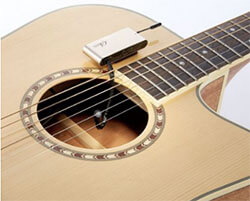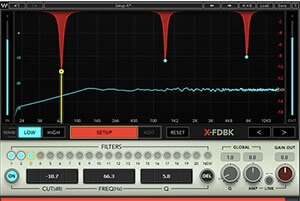 Amplify your sound with the iSolo, a microphone system designed specifically for acoustic guitars. iSolo is basically a small mic transmitter that transmits wirelessly to a receiver that amplifies your guitar. It comes in a small nicely designed box, a gooseneck microphone that you can turn to any direction and an antenna to transmit your sound.
Amplify your sound with the iSolo, a microphone system designed specifically for acoustic guitars. iSolo is basically a small mic transmitter that transmits wirelessly to a receiver that amplifies your guitar. It comes in a small nicely designed box, a gooseneck microphone that you can turn to any direction and an antenna to transmit your sound.
iSolo comes in three different packages ranging from $199 to about $349, you can choose from a USB receiver or a live receiver or why not both?
iSolo comes competitively cheaper than most brands in the market and is easy to use just plug and play.
Read more here: http://en.audiofanzine.com/misc-guitar-accessory/isolo/isolo/editorial/reviews/lone-pleasure.html
Live Sound
The All New Yamaha MX Synthesisers
Yamaha re-launches the MX Synthesisers, now ultraportable with new functions and design. The MX Synthesisers comes in two models, the 49 and the full sized key at 61, connected via USB just plug and play to your PC or Mac, no driver needed thanks to the class compliant technology. You can use it even in your IPad with the FM essential IOS app.
Weighing at 3.8 kg. for the MX49 and only 4.8 kg. for the MX61 it is very light and portable getting on and off the stage. Available in 3 striking colours, in stylish blue, classic black and the limited edition spectacular white.
Read more here: http://www.musictech.net/2016/07/yamaha-mx-synthesisers/
A Plugin To Eliminate Feedback From Your PA
 Every now and again we like to share stuff about live performance. this is mostly for musicians, but can also be useful for anyone using a PA for a live performance – magicians, actors, events with people speaking, etc.
Every now and again we like to share stuff about live performance. this is mostly for musicians, but can also be useful for anyone using a PA for a live performance – magicians, actors, events with people speaking, etc.
When I play live music with a PA system (sometimes we play small gigs without a PA), feedback is ALWAYS an issue. And there isn’t always a professional “sound guy/gal” in the back of the room that knows what to do about it, or has the gear to do it if they did. So what normally happens? The overall volume gets turned down and down until the feedback goes away. And this works, except for the fact that you might not be able to get your sound loud enough now.
Here is the basic problem. Sound is coming through the speakers and some of it comes back through the microphone to cause the problem. But it’s not ALL the frequencies (see my article-with-video on EQ and frequencies to learn more about THAT – What is Equalization, Usually Called EQ?) It’s usually only 1 or a couple of VERY narrow frequencies that are sort of getting trapped in the system and amplified over and over again until they overload the system AT JUST that frequency.
If we could turn down JUST that very specific and narrow frequency at a the source – which starts with making sure the mic is not facing the speakers, but after that is at the mixing board – we could eliminate the feedback. The tool needed at a mixing board is an equalizer, or EQ for short. You let the feedback ring and try turning down all the frequency volumes until you find the one responsible.
The problem with the EQ approach is that most mixing boards don’t have controls for enough frequencies! What do they usually have? You most often find 3 controls – one for bass frequencies, one for middle frequencies, and one for high frequencies. That is not enough precision. You really need at least like a 30-band graphic EQ that gives you controls at 31 different frequencies (actually frequency “bands”) from low (bass) to high.
So what you’re left with is the only option, which is to turn down ALL the frequencies (usually with the master volume knob/fader) until the feedback goes away. It seems a waste of available volume to tell all the frequencies to be quiet when only one or two of them are making trouble.
Even with the a 30-band EQ though, it can be difficult, not to mention loud for everyone in the room, to locate the correct frequency. And once you find the first one, there may be a second or third ready to cause more feedback. Wouldn’t it be cool if you had something that could immediately detect what frequencies were feeding back, and then immediately reduce the volume of JUST those frequencies? The correct answer is yes:).
And guess what? There is a tool that can do that. You’d need to have a computer at the mixing station. Maybe you’re using a computer to do all your mixing, which is possible now of course. But the Waves X-FDBK Feedback Eliminator is exactly the right tool for doing what I just described.
Below is a video showing how X-FDBK works:
You can find out more or buy the plugin from Waves Audio here.
World's First Dual Diaphragm Dynamic Microphone
 The Shure KSM8 Dualdyne microphone is the world’s first dual diaphragm dynamic microphone. This is pretty exciting stuff! Why? Well I should try to start at the beginning…sort of.
The Shure KSM8 Dualdyne microphone is the world’s first dual diaphragm dynamic microphone. This is pretty exciting stuff! Why? Well I should try to start at the beginning…sort of.
Okay, first you whould know the difference between a dynamic and a condenser mic. You can review our post – What Is the Difference Between Condenser and Dynamic Microphones? to do that. Basically, if you see someone holding a mic while singing live, that’s a dynamic mic (almost certainly). So the new Dualdyne mic is one of those.
Next, as you may have guessed form the title of the post, dynamic mics have always had only one diaphragm, which is the thing inside the mic that vibrates when you sing into it. Shure has sort of led the way in dynamic mic design, starting way back in 1939 with the Shure 55 “fatboy Elvis mic” (no comment about anyone’s weight or anything:-P). It was the world’s first single-element unidirectional microphone. That mic was designed to reduce feedback on stage and really was the foundation for every dynamic mic that came after. You can get a modern version of that here.
Then in 1964, Shure came out with the SM-57 and the SM-58 mics, which are so ubiquitous (they’re everywhere) that I’d be surprised if YOU didn’t have at least one of them in your house somewhere. the SM-58 was the first ice cream cone-shaped hand-held mic and continues to be the most popular live mic around.
These directional mics had what is called a “cardioid” pickup pattern, which means it is most sensitive in the front (where you would bite the ice cream), and least sensitive (which means it rejects sound – good for avoiding feedback and noise) from the rear – the area at the point of the cone would be. But this creates a well-known phenomenon called “proximity effect,” which means that as your mouth gets closer to the mic, it sounds deeper and muddier.
Shure had been looking for ways to deal with this, among other improvements in the hand-held dynamic mic and came up with the idea to put a second diaphragm inside the mic. In so doing, they ended up having to redesign everything inside the mic to make it happen. And the result is the KSM8 Dualdyne microphone, which, as we’ve mentioned, is the first-ever dual diaphragm dynamic microphone.
I will be acquiring one for review purposes in the coming weeks. Until then, check out the video below from Shure about the new mic. And if you want to learn more or buy one right now, CLICK HERE.
Learn How To Tell The Key Of A Song
Are You interested to learn how to tell the key of a song? In this article by Audio Fanzine talks about:
Check out the article HERE
